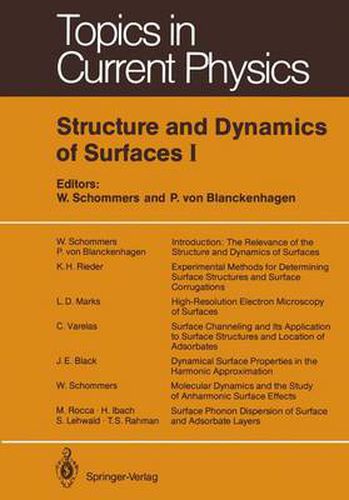Readings Newsletter
Become a Readings Member to make your shopping experience even easier.
Sign in or sign up for free!
You’re not far away from qualifying for FREE standard shipping within Australia
You’ve qualified for FREE standard shipping within Australia
The cart is loading…






This title is printed to order. This book may have been self-published. If so, we cannot guarantee the quality of the content. In the main most books will have gone through the editing process however some may not. We therefore suggest that you be aware of this before ordering this book. If in doubt check either the author or publisher’s details as we are unable to accept any returns unless they are faulty. Please contact us if you have any questions.
During the last decade, surface research has clearly shifted its interest from the macroscopic to the microscopic scale; a wealth of novel experimental techniques and theoretical methods have been applied and developed successfully. The Topics volume at hand gives an account of this tendency. For the understanding of surface phenomena and their exploitation in tech nical applications, the theoretical and experimental analysis at the microscopic level is of particular interest. In heterogeneous catalysis, for example, a chemical reaction takes place at the interface of two phases, and the process occurring at the surface is composed of a sequence of individual microscopic steps. These individual steps include adsorption, desorption, surface diffusion, and reaction on the surface. These elementary steps are greatly influenced by the structure and the dynamics of the surface region. Especially the catalytic activity may strongly depend on the structure of the catalyst’s surface. The necessity of per forming surface investigations on a microscopic scale is also reflected clearly in research work relating to metal-semiconductor interfaces which determine es sentially the properties of electronic device materials. The experimental probe on the atomic scale, coupled with parallel theoretical calculations, showed that the electronic properties of a metal-semiconductor interface strongly depend on the crystallographic structure of the semiconductor; in particular, it is im portant to know in this context the modification of the atomic arrangement in the surface region caused by the termination of the crystal by the surface.
$9.00 standard shipping within Australia
FREE standard shipping within Australia for orders over $100.00
Express & International shipping calculated at checkout
This title is printed to order. This book may have been self-published. If so, we cannot guarantee the quality of the content. In the main most books will have gone through the editing process however some may not. We therefore suggest that you be aware of this before ordering this book. If in doubt check either the author or publisher’s details as we are unable to accept any returns unless they are faulty. Please contact us if you have any questions.
During the last decade, surface research has clearly shifted its interest from the macroscopic to the microscopic scale; a wealth of novel experimental techniques and theoretical methods have been applied and developed successfully. The Topics volume at hand gives an account of this tendency. For the understanding of surface phenomena and their exploitation in tech nical applications, the theoretical and experimental analysis at the microscopic level is of particular interest. In heterogeneous catalysis, for example, a chemical reaction takes place at the interface of two phases, and the process occurring at the surface is composed of a sequence of individual microscopic steps. These individual steps include adsorption, desorption, surface diffusion, and reaction on the surface. These elementary steps are greatly influenced by the structure and the dynamics of the surface region. Especially the catalytic activity may strongly depend on the structure of the catalyst’s surface. The necessity of per forming surface investigations on a microscopic scale is also reflected clearly in research work relating to metal-semiconductor interfaces which determine es sentially the properties of electronic device materials. The experimental probe on the atomic scale, coupled with parallel theoretical calculations, showed that the electronic properties of a metal-semiconductor interface strongly depend on the crystallographic structure of the semiconductor; in particular, it is im portant to know in this context the modification of the atomic arrangement in the surface region caused by the termination of the crystal by the surface.